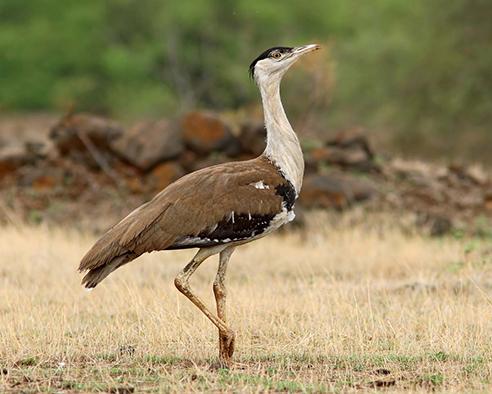Great Indian Bustards (GIBs) | 25 Oct 2022
For Prelims: Desert National Park, International Union for Conservation of Nature Red List, Species Recovery Programme.
For Mains: Measures for the protection of Great Indian Bustards
Why in News?
The recent sighting Great Indian Bustards (GIBs) deep in Pakistan’s Cholistan desert has given rise to speculation that the endangered birds might have flown across the international border from India’s Desert National Park (DNP).

What are the Key Points About Great Indian Bustard (GIB)?
- About:
- The Great Indian Bustard (Ardeotis nigriceps) , the State bird of Rajasthan, is considered India’s most critically endangered bird.
- It is considered the flagship grassland species, representing the health of the grassland ecology.
- Its population is confined mostly to Rajasthan and Gujarat. Small populations occur in Maharashtra, Karnataka and Andhra Pradesh.
- Threat:
- The bird is under constant threats due to collision/electrocution with power transmission lines, hunting (still prevalent in Pakistan), habitat loss and alteration as a result of widespread agricultural expansion, etc.
- Protection Status:
- International Union for Conservation of Nature Red List (IUCN): Critically Endangered
- Convention on International Trade in Endangered Species of Wild Fauna and Flora (CITES): Appendix1
- Convention on Migratory Species (CMS): Appendix I
- Wildlife (Protection) Act, 1972: Schedule I
- Measures taken to protect GIB:
- Species Recovery Programme:
- It is kept under the species recovery programme under the Integrated evelopment of Wildlife Habitats of the Ministry of Environment, Forests and Climate Change (MoEFCC).
- National Bustard Recovery Plans:
- It is currently being implemented by conservation agencies.
- Conservation Breeding Facility:
- MoEF&CC, Rajasthan government and Wildlife Institute of India (WII) have also established a conservation breeding facility in Desert National Park at Jaisalmer in June 2019.
- The objective of the programme is to build up a captive population of Great Indian Bustards and to release the chicks in the wild for increasing the population.
- Project Great Indian Bustard:
- It has been launched by the Rajasthan government with an aim of constructing breeding enclosures for the species and developing infrastructure to reduce human pressure on its habitats.
- Eco-Friendly Measures:
- Task Force for suggesting eco-friendly measures to mitigate impacts of power transmission lines and other power transmission infrastructures on wildlife including the Great Indian Bustard.
- Species Recovery Programme:
What are the Key Points About Desert National Park?
- It is situated on the western border of India within Jaisalmer & Barmer Districts of Rajasthan.
- Great Indian Bustards, Rajasthan State animal (Chinkara) and State tree (khejri) and State flower (Rohida) are found naturally at this park.
- It was declared a UNESCO World Heritage Site in 1980 and National Park in 1992.
UPSC Civil Services Examination Previous Year Question:
Q. With reference to India’s Desert National Park, which of the following statements are correct? (2020)
1. It is spread over two districts.
2. There is no human habitation inside the Park.
3. It is one of the natural habitats of Great Indian Bustard.
Select the correct answer using the code given below:
(a) 1 and 2 only
(b) 2 and 3 only
(c) 1 and 3 only
(d) 1, 2 and 3
Ans: (c)
